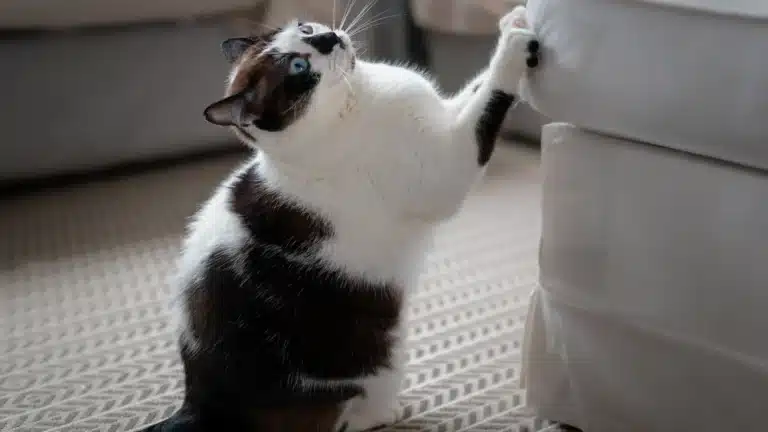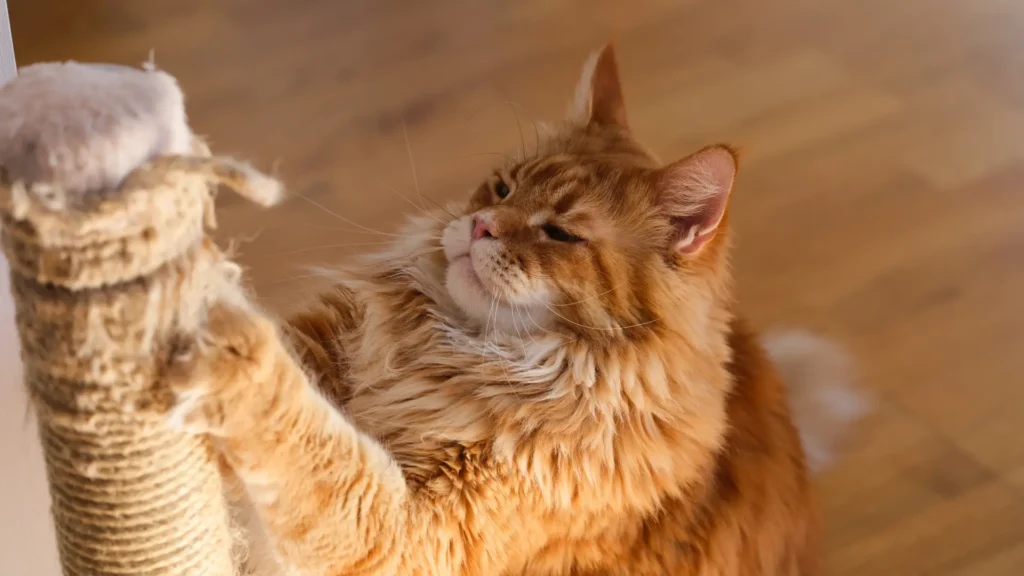If you’re a cat owner, you’re probably familiar with the occasional frustration that comes with seeing your beloved feline scratching at your furniture. It can seem impossible to tackle, but the good news is that you can teach your cat to stop this behaviour. So, let’s look at why cats like to scratch, how you can guide them to stop, and what steps you can take to keep your furniture safe and your cat happy.

Why Is Training Important?
It’s not about making them stop scratching entirely. That would be unfair and unnatural. Your goal is to redirect the behaviour. You want your cat to scratch things that are okay to scratch — not your sofa.
This isn’t about punishment. It’s about smart setup, consistent reinforcement, and patience.
- Training Isn’t Just for Dogs: Many people think cats can’t be trained, but that’s not true! While they may not sit and stay like dogs, cats can learn what is okay and what is not. Especially when you use kindness, consistency, and some clever tricks.
- A Happy Cat = A Scratch-Free Home: Providing your cat with healthy ways to scratch, along with healthy scratching options, helps them feel secure and satisfied. It also saves your sanity (and your furniture). Once they know what’s expected, they’ll often go right for the scratching post instead of the sofa.
- The Benefits of Redirecting Scratching Behaviour: Training your cat to avoid scratching your furniture is important for maintaining a peaceful and clean home. You can prevent damage by redirecting this natural behaviour while satisfying your cat’s instinctual need to scratch. Additionally, training fosters a better relationship between you and your cat as you guide them toward more appropriate behaviours.
- Safety and Emotional Well-Being for Your Cat: Providing your cat with suitable scratching alternatives helps reduce stress and anxiety. Without proper outlets for scratching, cats may become anxious or stressed.
Preserving Your Furniture and Home: Training your cat helps protect your belongings from claw damage. Keeping your furniture scratch-free enables you to maintain a lovely home while ensuring your cat stays happy and content!
Understanding Cat Scratching
Scratching is a typical behaviour for all cats, serving several important purposes. Remember, scratching isn’t being naughty; it’s a natural instinct!
- They’re Marking Territory: Cats have scent glands in their paws. When they scratch surfaces, they leave a visible mark and a scent message that signals, “This is mine.” The urge to mark territory can increase in homes with multiple cats or when a cat observes the outdoors from a window.
- They’re Maintaining Their Claws: Scratching allows cats to keep their claws healthy and sharp. Additionally, scratching strengthens the muscles in their paws.
- It Feels Good: Stretching their backs, wiggling their toes, and kneading into something soft brings such a cozy vibe to our furry friends, the cats! These behaviours are a big part of their daily routine and serve some important purposes. Not only do they help stretch and loosen their muscles, but they also allow cats to mark their favourite spots. Whether it’s a fluffy blanket, a sun-warmed patch of carpet, or their beloved piece of furniture, each surface offers a delightful sensation that helps them feel super comfy and right at home!
The Impact of Scratching on Your Furniture
When it comes to our cats, scratching is completely normal behaviour! However, it can become a problem if their favourite spot happens to be your brand-new recliner’s armrest. Cat claws can do some serious damage in no time! That’s why it’s so important to show your cat where they can scratch appropriately. Cats often love to scratch on items covered with fabric. So, it’s beneficial to address this behaviour early on. This will help avoid any expensive repairs or replacements and keep both your furniture and your kitty happy!
Steps to Train Your Cat to Stop Scratching Furniture
Step 1: Offer Better Options
First things first—give your cat a better place to scratch. This is the biggest mistake people make. They get one small, flimsy scratching post and expect it to solve the problem. Invest in one or two good scratching posts, pads, or boards. They come in all shapes and sizes, so you might have to try a few to find what your cat loves. The right type of scratching post can redirect their attention from your furniture.
Material Matters: Sisal, Cardboard, or Carpet? Cats have preferences! Sisal-wrapped posts are a big hit with many cats.- Vertical vs. Horizontal: Some cats like reaching up and stretching, while others prefer flat scratching pads on the floor.
- Placement is Key: Put the new scratching post next to the furniture they usually scratch. Once they start using it, you can slowly move it to a more convenient spot.
Step 2: Positive Reinforcement Methods
Cats are not like dogs, they don’t respond to punishment. Cats respond better to positive reinforcement. When your cat uses their scratching post instead of your furniture, reward them with treats, praise, or affection. Positive reinforcement helps your cat understand that scratching the post is a desirable behaviour.
- Use High-Value Treats: Offer treats your cat loves immediately after they use the scratching post.
- Praise and Petting: Cats are highly motivated by attention and affection. After they scratch the post, give them plenty of praise and affection.
- The Clicker: You can even use clicker training if you’re into that — yes, it works for cats, too.
Step 3: Make Furniture Less Appealing
While you’re encouraging good scratching behaviour, you’ll also want to protect your furniture. There are a few simple tricks to make scratching the couch a lot less tempting:
- Double-Sided Tape: Cats dislike the sticky feeling, and placing tape on your furniture can deter scratching.
- Furniture sprays: Some deterrent sprays have citrus scents that cats dislike. Just be cautious, some cats don’t care, and some people do.
- Furniture covers or foil: Temporarily covering a favourite scratch spot can help break the habit.
Step 4: Be Consistent and Patient
Cats learn best when you maintain a routine. Consistency in your training efforts is crucial, so persevere for a few weeks and don’t get discouraged if you don’t see immediate results. Some cats pick things up quickly, while others may take a little longer to learn. During training sessions, keep them short and positive, gradually increasing the time your cat spends on the scratching post.
Step 5: A little extra motivation never hurts
- Catnip or Silvervine: Enhance your cat’s scratching experience by rubbing a bit of catnip on their new scratching post! The delightful scent of catnip can make the posts super irresistible for your furry friend. Plus, some scratchers even come pre-infused with this fun herb, so your kitty will be drawn to them right away! However, not all cats are responsive to catnip; if that’s the case for your pet, consider using silvervine instead. This natural alternative often captivates cats who may not react to catnip, ensuring every kitty can enjoy their new scratching spot.
- Feliway: This is a synthetic pheromone that helps cats feel calm and secure. It comes in a spray or plug-in form. While it won’t stop scratching directly, it can help reduce stress, which often leads to less stress-related scratching.
Step 6: Trim Their Nails Regularly
Shorter claws = less damage. Trimming every 2–3 weeks helps prevent them from becoming too sharp. It also reduces the urge to file them down on your furniture.
If you have never trimmed your cat’s nails before, take it slow. Start off by playing or massaging your cat’s paws daily and giving them a treat. Slowly work up to clipping one or two nails at a time. Or have a groomer or vet do it if you don’t feel comfortable with it.
Never declaw. It’s not just a nail removal. It’s an amputation. It can lead to pain, behavioural issues, and long-term health problems.
Step 7: Understand Triggers for Stress Scratching
Sometimes, scratching is more than just instinct. It’s anxiety. If your cat is scratching more than usual, ask:
- Has something changed in the home?
Are there new people or pets? - Is there construction noise outside?
Have you moved furniture or litter boxes? - Cats don’t love change. Scratching helps them cope. If you can reduce the stressor, that would be great. If not, focus on more environmental enrichment: puzzle toys, play sessions, window perches, etc.
Is Your Cat Scratching Out of Stress?
Sometimes, a sudden increase in scratching can be a sign your cat is stressed or anxious. Significant changes—such as moving to a new house or getting a new pet—can lead to increased clawing as a coping behaviour. In these cases, comfort and routine are key.
- Provide safe hideouts.
- Use calming sprays or diffusers.
- Spend extra time playing or cuddling.
FAQs
Do Soft Paws (Claw Caps) Work?
Yes, for some cats. These are small plastic caps you glue onto your cat’s claws. They fall off as the claws grow. They’re a temporary solution — they don’t teach your cat what to scratch, but they can protect your furniture in the meantime.
Just be sure your cat tolerates them and that you apply them correctly. Some cats hate them, others don’t mind.
How Many Scratching Posts Do I Need?
At least one per cat, plus one extra. Place them in high-traffic or high-value areas — near the couch, by windows, or next to their favourite sleeping spot.
Will Getting Another Cat Help?
Not necessarily. It could reduce boredom, or it could add more stress. And more cats mean more need for territory — including more scratching areas.
The key is thinking like a cat. They’re not being “bad.” They’re being cats. Your job is to give them better ways to be themselves — without destroying your couch in the process.
Bonus: Products That Actually Help
- Frisco 32-inch Sisal Cat Scratching Post: Tall and sturdy.
- PetFusion Ultimate
- Cat Scratcher Lounge: Doubles as a horizontal scratcher and chill spot.
- Sticky Paws Furniture Strips: Easy to apply and remove.
- SmartyKat Catnip Mist: Spray it on new posts to attract interest.
- Feliway Classic Diffuser: Great for new cats or stressful changes.
Cats naturally love to scratch, so by providing them with suitable alternatives, such as scratching posts or mats, you can guide them away from your cherished furniture. Don’t forget to celebrate their successes with treats and praise! This positive reinforcement not only helps to protect your home but also keeps your kitty happy and healthy.
With some time and consistency, your cat will start to learn the best places to scratch. You’ll both be able to enjoy a cozy, peaceful space together.

